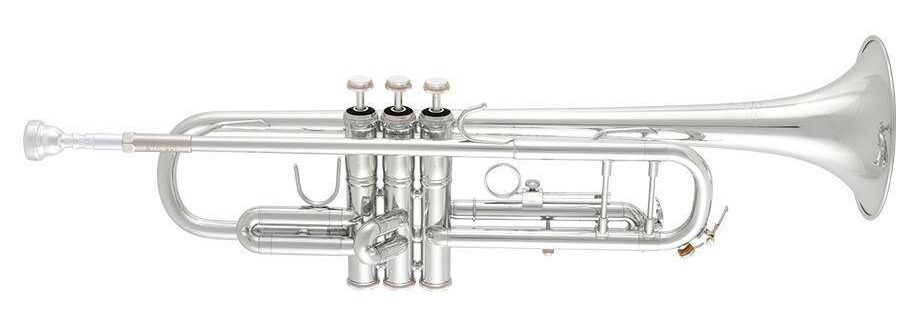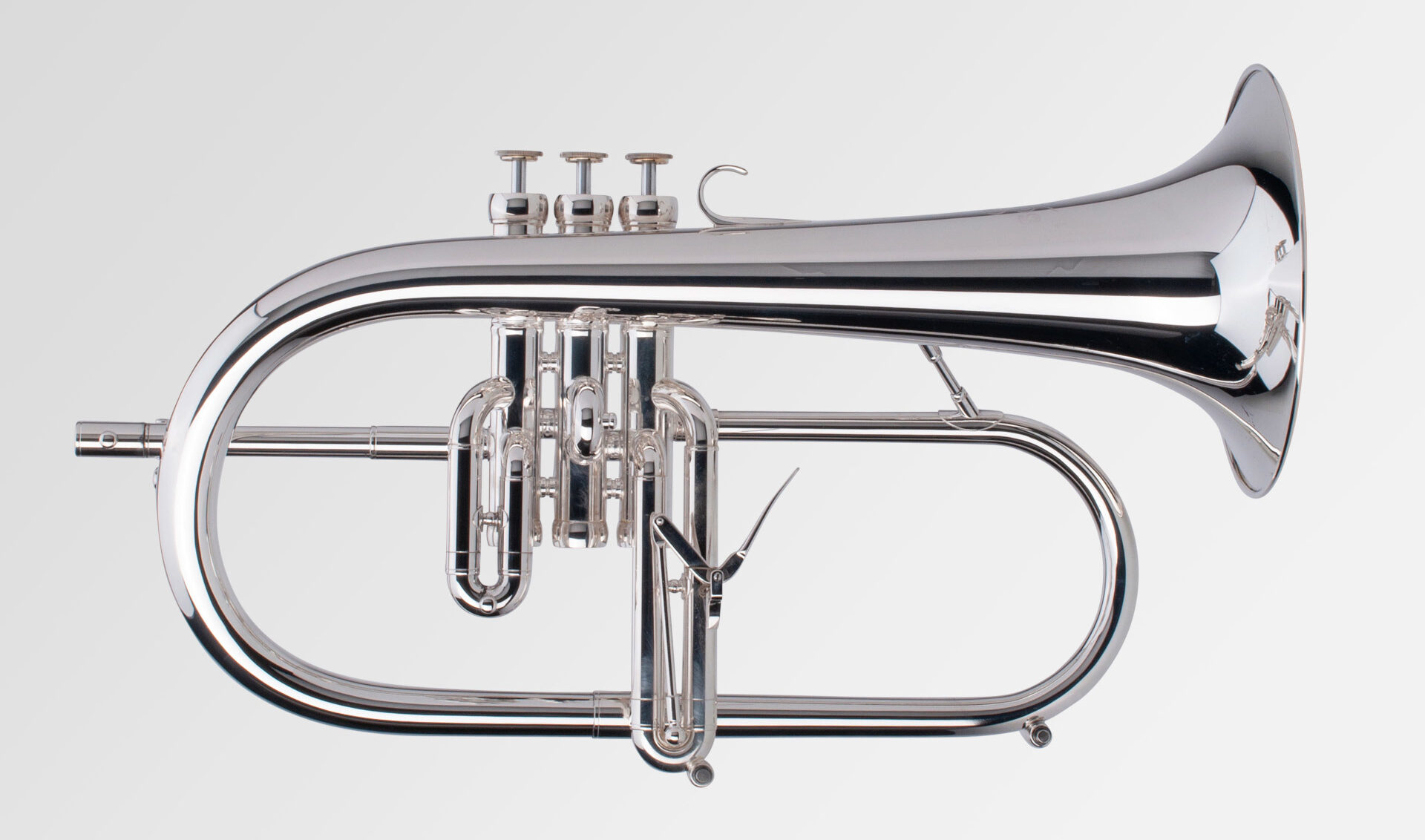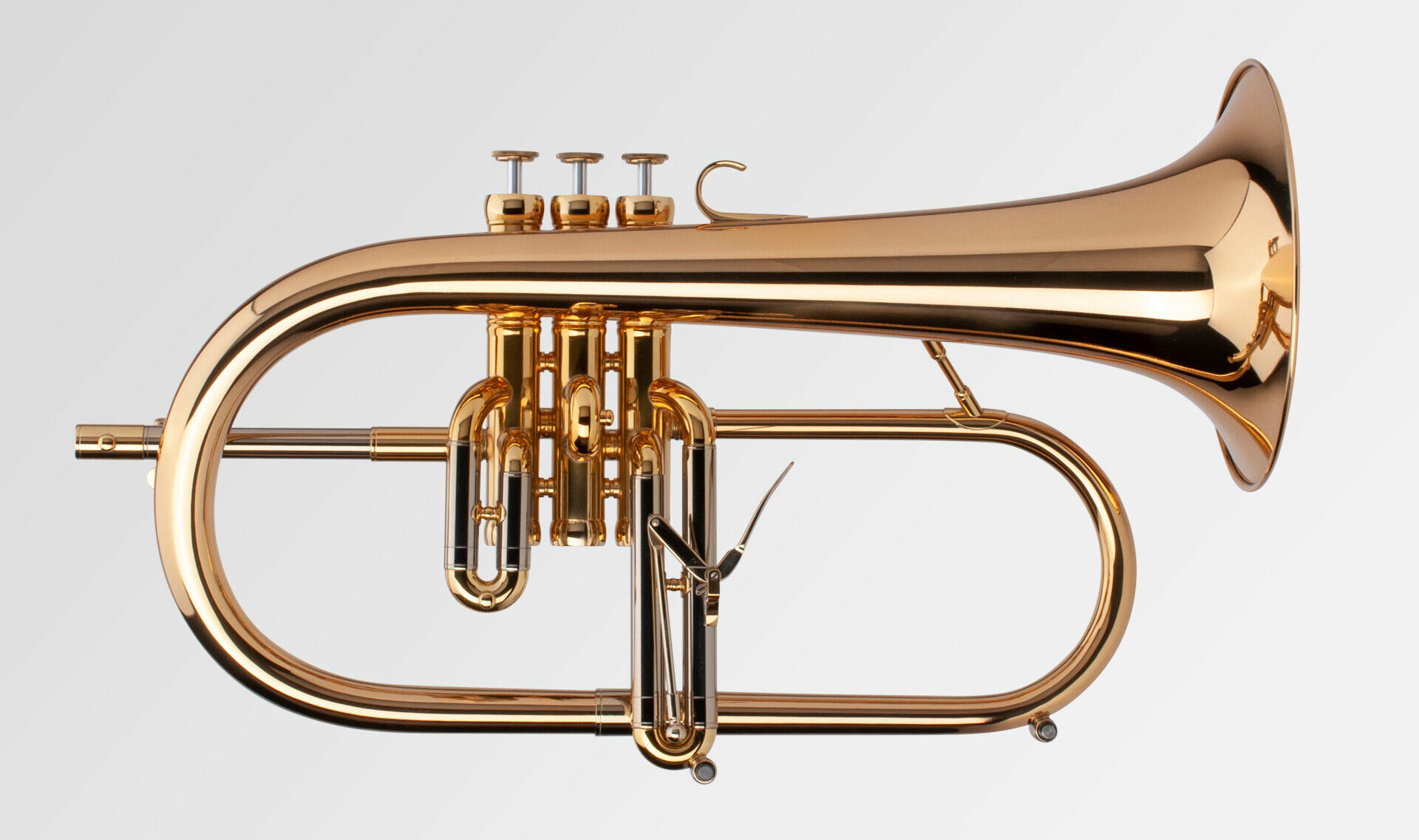- How to Find the Best Fugelhorns - May 27, 2022
“There is a consensus among musicologists and historians that over the course of time, no musical instrument has changed with regard to its construction, purpose, and symbolism more so than the trumpet.” (Tarr, 1988) (Koehler, 2014)
The history of trumpet can be originated from the beginning of human civilization. In ethnology, the words ‘trumpet’ and ‘horn’ are often exchanged and equally used for all wind instruments, which are sound by lip vibration regardless of their material.
It is important to mention, that all of today’s brass instruments are originated from ancient trumpets and horns, which leads to the conclusion, that we call an instrument a ‘brass instrument’ if it is sound by lip vibration regardless of its material.
That is the reason why a saxophone made of brass belongs to the woodwind family, and a plastic trumpet is still a brass instrument.
At a later stage of trumpet/horn development, several variations and sizes of ‘trumpets’ were made and as they became conventional, they got their own specific names such as trombone, tuba, French horn, and nowadays we only call a small group of brass instruments a trumpet.
Prehistoric Trumpet History
The first ancient forerunners of trumpets were made of horn or shell and some of them were only able to intensify the player’s voice, so it didn’t definitely serve as a substantive instrument. The aim of these horns was spiritual; they used their voice to frighten bad spirits.
Due to the development of the instrument, this aim has changed deliberately. In the following article by The New York Times, you can listen to a sound of a 17000-year-old shell horn.

Following the schema of many other areas in history, similar horn variations appeared in different parts of the world. However, this article is not willing to dive deep into the ancient forerunners of today’s trumpets, it is important to mention and describe a few:
- The Jewish shofar is one of the best-known animal horns. It has a religious aim and is still in use these days. It is usually able to generate two notes a fifth apart from each other.
- The Greek Keras is very similar to a shofar, however, it was later further developed
- In India there were many different animal horn varieties such as the shringa, kombu, singhavisan, and so on. They are generally made of buffalo horn, however, some of them has a special bamboo mouthpiece.
- A well-known type of ancient trumpets is the didjeridu from Australia. It has a slightly different method of playing and it is still in use nowadays.
- There are many other examples from all over the world such as the Germanic Stierhorn, the engombe form Uganda or the rwa-dun from Tibet.
Ancient Trumpet History
As prehistoric trumpets were commonly made of raw animal horns with temperate modifications, in the ancient time’s people processed different materials with more complex concepts to create better and better trumpets and horns.
The utilization of trumpets also started to widen; in addition to their religious usage, they became essential elements of wars, triumphs, and events.
- The first instruments that can be truly called as trumpets originate from ancient Egypt from the Tutankhamun-era; they are called sheneb. These natural horns were made of wood, bronze, copper or silver without a separate mouthpiece and were initially used for military reasons. In the below BBC article, a record of its sound can be found together with its adventurous history.
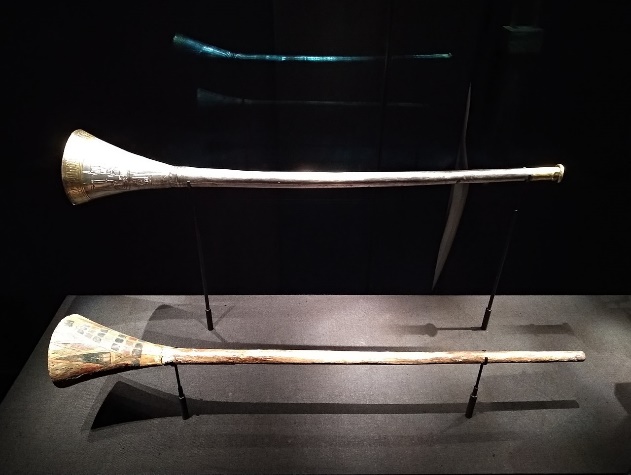
- Apart from the shofar many different types of primitive trumpets from Israel are referenced in the Bible such as the taqowa as a military horn, or the hasoserah, which is well-illustrated on the Triumphal Arch of Titus from the second century.
- In ancient Greece the salpinx was used as a war trumpet and it most probably followed the pattern of the Egypt trumpet, sheneb as referenced before. The 157 cm long salpinx was made of bronze and ivory and had an appropriate mouthpiece. The first trumpet notation can be linked to the salpinx as well from 500 BCE, which can be seen in the below image (TO TO TE TO TH). It is a fun fact, that at the Olympic Games from 396 BCE a trumpet contest was organized of who can play louder. (Bowyer, 2015)

- In ancient Rome many types of natural trumpets were used based on Etruscan concepts, such as the tuba, cornu, buccina and lituus. The Roman tuba is a one-meter-long natural horn, which is much different from today’s tubas and can be rather treated as a natural trumpet. Ancient Roman scripts refer to trumpet sounds as horribilis (“horrible”), terribilis (“terrible”), raucus (“raucous”), rudis (“coarse”) or strepens (“noisy”), which helps us to gain a picture of trumpet’s role, which was far from being musical. However, he cornu instrument was slightly bended (which wasn’t a common technique at that time) and therefor it could be longer than the other trumpets and was able to play more of the harmonics. At the below video a cornu (constructed based on an instrument found in Pompeii) is being played:
- “After the fall of the Western Roman Empire in 476 CE, the trumpet disappeared from Europe for more than half a millennium.” (Costa, 2019) Since in the ‘Dark Ages’ development was more relevant in the Middle East and Asia, trumpet evolution was also located in these areas instead of Europe. It is important to recognize, that the Saracens created their own natural trumpets based on the Roman tuba, which was brought back to Europe by crusading Christian armies around 1100.
Good to Know: The Harmonic Series
Trumpet development took giant steps in the 14th century and to better understand the development concepts and challenges, it is mandatory to get a taste of how trumpets work. The base structure of the trumpet is the harmonic or overtone series. To understand it, we should start with tone attributes.
A tone can be described by many physical characteristics such as frequency (the shorter the wavelength, and higher the frequency, the higher the note sounds), amplitude (loudness), or color.
The tone’s color is defined by its frequencies. If a tone has only one frequency, it sounds like a digital watch alarm of a whistle. Musical notes generally include more frequencies, so they are more colorful and provide a full sound. “…a very particular set of frequencies is heard.
Each note that comes out of the instrument is actually a smooth mixture of many different pitches. These different pitches are called harmonics, and they are blended together so well that you do not hear them as separate notes.” (Earmaster, 2020)
The notes of the harmonic series are set of frequencies that are positive integer multiples of a common fundamental frequency as can be seen on the below image:

(Offermans, 2012)
So, let’s translate physics into musical notes: if A is the fundamental, its frequency is 440 Hz, and an octave above (as the second harmonic) will have 880 Hz. The third harmonic will be a fifth above (E) with 1320 Hz and so on. As earlier said: the higher the frequency, the higher the note sounds. The below image shows the harmonics of the low C.
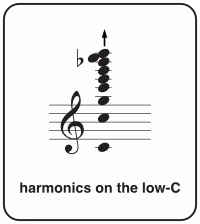
This harmonic series shows us which notes can be played on a natural trumpet from the 14th century (or with one fingering on a valve trumpet), while it also helps us to see which notes’ frequencies can be found in one musical note. The use of the harmonic series on today’s valve trumpets will be described later.
Trumpet in the Middle Ages
The main achievement for the trumpet in the Middle Ages was, that its role expanded. As described earlier, its sound wasn’t musical and therefore its role was rather just to make noise for frightening ghosts or call for attention – thanks to the instrument’s limited capabilities.
Role and construction walk hand in hand: if there’s a demand for a specific sound or technique, trumpet construction must be able to produce it; but if a developed instrument is capable to reach new limits, provide new characteristics, composers will consider applying these new instruments in their music.
In the Middle Ages, the trumpet stepped into the musical sphere and this is the point from where we can really call the trumpet a musical instrument.
The Renaissance
However straight trumpets were able to play basic musical pieces, the invention of tubing was a breakthrough in trumpet history. Before trumpet manufacturers were able to bend tubes, the instrument’s length was limited and therefore only 3 harmonics of the harmonic series could be played.
As can be seen at the below “reconstruction of a typical 14th-century trumpet/woodwind piece by Herbert Heyde, the upper part – played by a shawm – is considerably more florid than the lower part, played by the trumpet.” (Tarr, 1988)

14th-century music from an alta ensemble
So, in the beginning of the renaissance, around 1400, manufacturers started to experience different melting points of different metals, and with the revolutionary invention of bending they could reduce the instrument’s length to one third, but the length of the tube could be longer as before, and therefore the player could reach more of the harmonic series.
As seen in the harmonic series part, the higher we go in the harmonic series, the closer the notes are to each other. This upper register, called ‘clarino’ therefore enables musicians to play more complex melodies.
From this era, straight trumpets were generally used for ceremonial music in royal courts (such as the six feet long buisine), while bent natural trumpets became part of mainstream music.
Another important deployment was the slide trumpet. Its mechanics are similar to today’s trombones, however, due to its mouthpiece and bore size its register is much closer to the trumpet’s.
Although the bended slide trumpet could cover more harmonics of the harmonic series than the former straight trumpets, until Baroque it wasn’t treated as a virtuoso solo instrument, it usually played the cantus firmus.

Renaissance slide trumpet
A completely different way of innovation resulted in the cornetto.
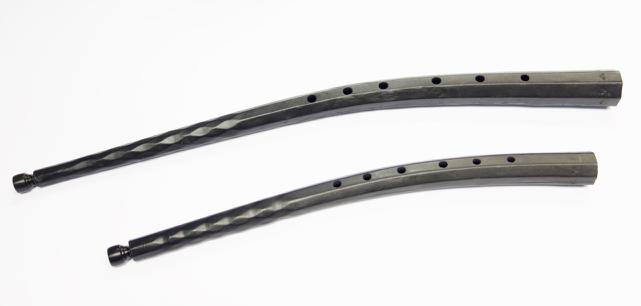
Renaissance cornettos
It is quite an interesting instrument from today’s perspective since due to its tone holes it rather looks like a woodwind instrument (for example the clarinet), however, it uses the same lip vibration technique as the trumpet to produce sound, therefore it is a treated as a brass instrument.
Despite the great invention of metal bending, the cornetto was made of wood. Thanks to its tone holes “the cornetto, by virtue of its more complex woodwind-esque construction, was able to play all the notes in the diatonic system, as well as chromatic pitches.” (Christensen, 2016)
The tone holes and different finger combinations resulted that the cornetto was one of the most common solo instruments of the 16th century. An excerpt from Giovanni Paolo Concerti Ecclesiastici from 1610 well illustrates the cornetto’s capabilities.

The Baroque Era
In the Baroque era, bent trumpets went through a serious development process, their tone was closer to the human voice than the cornetto’s and thus they became more popular than the cornetto. Special mouthpieces were manufactured and therefore it was easier to play clear and on a nice tone.
The former loudness competitions of ancient Greek Olympic Games transformed to balanced, emotional orchestral playing. With the lack of diatonic notes in all registers, players had to use a special mouth technique. “Here and there, trumpeters must push a given note upwards or downwards by the strength of their lips […]
By means of this technique, the player can perform many passing notes written outside the harmonic series” (Tarr, 1988) The other new technique was, that musicians had to dismiss the former habit of blowing up their cheeks, and had to keep their mouth corners firm.
The new types of instruments, mouthpieces, and new requirements forced players to create fundamentally new techniques and to read sheet music. These new challenges required the first trumpet methods to be created.
One of the most remarkable first trumpet methods is Girolamo Fantini’s Modo per imparare a sonare di tromba from 1638. The method even contained 8 pieces for trumpet and organ.
A great example of how acknowledged the trumpet became in the baroque is Claudio Monteverdi’s Orfeo (1607), where a five-trumpet chorus plays in the Overture. In the below excerpt it can be clearly seen, that the first line is written in the clarino register and plays diatonic parts.

Even Michael Praetorius draws our attention to what difference the proper technique can make in the art of trumpet playing: “Trumpet is a great instrument if it is played by a real master, who can lead it with art and able to control it.” (Vogelsänger, 2008)
The three most important composers, who often used the trumpet in the Baroque were Händel, Bach and Purcell. Händel’s famous Water music includes remarkable parts of trumpet choirs.
By the end of the Baroque era some virtuoso pieces were written for trumpet masters, such as Bach’s Brandenburg concertos for the trumpet player Gottfried Reiche. The second Brandenburg concerto is still one of the most difficult pieces for trumpet players due to its high register and fast tempo.
Originally it was played by a natural trumpet in F, today this piece is rather played by a piccolo trumpet. Another famous Bach piece, where the trumpet has a leading role is the Christmas Oratorio. Its manuscript is attached below:

Johann Sebastian Bach: Weihnachtsoratorium, BWV 248
The Baroque trumpet literature plays such an important role in the history of the trumpet, that pieces of Bach, Hertel, Telemann, Torelli, Leopold Mozart, Michael Haydn are still parts of trumpet studies today and can be often heard in concerts, recitals, or CDs.
From our modern perspective, the Baroque trumpet soloists could be like stars. They were allowed to only pay attention to their solo career, they got high salary and unique clothes and were celebrated by the audience. It is also remarkable, that trumpet methods by the end of the 18th century were not only collections of sheet music, but well-thought methodologies of how to teach the trumpet.
The first German trumpet method (Versuch einer Anleitung zur heroisch-musikalischen Trompeter- und Paukerkunst) was written by Johann Ernst Altenburg in 1795 and explains teaching as follows: “…I play the low register’s five-six notes (c-g-c-e’-g’-c’), then play together with the student and later let him play alone until he gets tired. Until that, I note what we played so he gets used to reading sheet music.” (Altenburg, 1795)
However, the trumpet improved a lot in Baroque and became an orchestral and solo instrument, the construction still wasn’t perfect.
It was still only able to play the notes of the harmonic series of its pitch, therefor different pitched instruments were needed for pieces in different keys (most trumpets were keyed in D), and chromatically playing was mainly available by the special lip technique as described before.
These challenges desired further developments. One possible development was Charles Clagget’s Inventionstrompete, which contained exchangeable slides for three different keys. However, it hadn’t become a general solution at that time, today’s Eb/D or A/Bb piccolo trumpets follow the same idea.

Baroque natural trumpet with exchangeable slide
Legacy of Baroque Trumpets
In the 20th century Baroque music became popular again. The world-famous trumpet master Maurice Andre has a leading role in it. He played Baroque pieces on piccolo trumpet, which was more suitable for the clarino register, than the former Baroque trumpets were.
The newly invented piccolo trumpet helped the player to be clearer and be able for musical interpretation, which made it very popular. Andre created transcriptions of sonatas, which were mainly written for oboe.
From the second half of the 20th century, several types of research have been started about Baroque music, which resulted in the recreation of Baroque instruments, such as the Baroque trumpet. One of the most acknowledged methods about Baroque trumpet playing is the formerly cited Edward H. Tarr’s Die Kunst des Barocktrompetenspiels.
It contains exercises for the principal and clarin registers as well and gives instructions on the appropriate articulation. These researches and re-built instruments help us to have a sight of how ensembles in the Baroque could sound.
Trumpet in the 19th Century
It is not a question, that ideologies and fashion change from time to time, and with the start of the Classical period, unfortunately, trumpet wasn’t that popular as before. The new musical taste didn’t require bright, soloistic trumpets: “The new style made a tutti instrument of the once heroic trumpet, which formerly had led the melody.
Sometimes a short fanfare which closed an allegro movement, or a symphony called attention to the trumpeters’ surviving court function.” (Tarr, 1988) Another historical input is that many monarchies were changed to democracies and the sponsoring of expensive trumpet manufacturers decreased.
A good example of the regression of the trumpet is Ludwig van Beethoven’s Leonore Overture (1805), which requires the lower parts of the harmonic series, and uses the instrument for a fanfare:

Leonore Overture #3(Beethoven, Op. 72b), mm. D.21-26
- An interesting experiment was the hand trumpet or half-moon trumpet built by Michael Wöggel in the 1770s. Wöggel created a shorter trumpet by adding more blends, and therefore the player could hand-stop the air at the bell and change the pitch by a semi-tone (similar to French horn players).

Demi-lune(half-moon) trumpet
- The persistent deployments however led to the so-called Keyed Trumpet (Klappentrompete) designed by Anton Weidinger in 1796, which was able to play chromatically. However, it was popular only for a short period of time, it has a remarkable effect on trumpet history since two of the most famous trumpet concertos – the Joseph Haydn and the Johann Nepomuk Hummel concertos – were written for this type of instrument. The Haydn trumpet concerto is still the most played piece in auditions today.

The keyed trumpet by Anton Weidinger

Concerto for Trumpet –I. Allegro (Haydn, Hob. VIIe:1), mm. 37-44
At the beginning of the 19th century, we arrived at the biggest invention of trumpet history: the valves. The valve system meant the answer to many challenges. With the new invention, it was possible to play chromatically in all registers of the instrument on balanced tones with easy, flexible, but firm movements.
The new instrument has a central valve system, which can lead air to three additional slides (one slide per ventil). The three slides have different lengths and they can change the tone with half, one, or one and a half pitches and they can be combined.
There were many different experimental valve constructions, however, only two of them are still in use today. The rotary valve was invented in 1832 by Joseph Riedl, which construction is still in use mainly in Austria and Germany.
The other type, the so-called Périnet-valve (or piston valve) was invented by Francois Périnet in 1839, in Paris. (The first valve was probably manufactured by Charles Clagget in 1788, but none of his instruments survived, so there is no confident evidence for the existence of his valved trumpets).

The Périnet-valve in operation

Operation of the rotary valve
With different valve combinations, the player is able to play all 12 notes of a chromatic scale by building up a harmonic series on all valves and valve combinations. It’s worth checking Yamaha’s illustrations on how valve combinations work.
Soon after valves were invented for the trumpet, a new instrument, the cornet was created. The cornet is a developed version of the posthorn with valves. It had a higher pitch, a softer, darker sound, and was better to play virtuoso pieces.
The instrument became so popular, that it fueled serious debates among composers, players, and manufacturers about which instrument should be used generally.
The cornet was often used as a solo instrument but also in military bands. One of the first and most famous cornet players were the French Joseph Jean-Baptist Arban, who created his trumpet method (La Grande Méthode Compléte de Cornét á Piston et de Saxhorn) at the Conservatoire in 1864, which is still today the most fundamental trumpet method.
Arban as a performer and teacher was a close friend of Adolf Sax, who was one of the better wind instrument manufacturers at that time. It is important, that Hector Berlioz often discussed the actual developments of trumpet and cornet and wrote his pieces accordingly.
The final version of the cornet- which is very close to today’s cornets – was built by Antoine Courtois with the help of Arban.
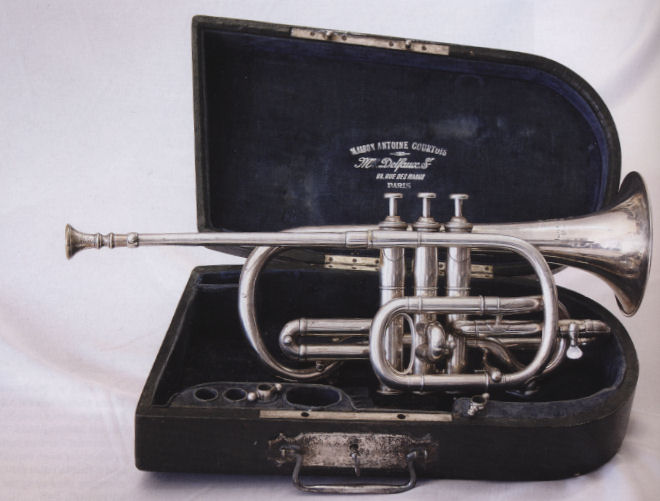
The Arban-Courtois cornet in Bb/A
In the middle of the 19th century, the former F trumpets were replaced by Bb, A, or C trumpets, which is meant to be the end of the great inventions and developments of the trumpet. After WWII due to the American wave, many players replaced their rotary valve (Germany type) trumpets with piston valve ones.
Today professional players own both rotary and piston valve trumpets and use them to match the played piece’s characteristics. In the 20th century, the trumpet is still a popular instrument and can be found in almost every music style such as contemporary, jazz, pop, rock, disco, reggae just to name a few. (Velenczei, 2011)
Additional Trumpet Types
In the 20th century, the trumpet reached its final form and the aim was not to solve issues of the instrument anymore but to concentrate on fine-tuning its characteristics to suit different musical styles and modulate the interpretation accordingly. That is the reason, why in the 20th century some new instruments were born based on the concept of the trumpet.
- Flugelhorn: The flugelhorn has the same pitch as the Bb trumpet, but it has a darker, emotional sound. It was first manufactured by Heinrich Stölzel in Berlin in 1828, however, the base of today’s valve flugelhorns was built by Adolf Sax. The flugelhorn has rotary and piston valve variations and was originally used in military bands. In the second half of the 20th century, it was made an iconic instrument of jazz by players like Clark Terry, Freddie Hubbard, or Chuck Mangione.
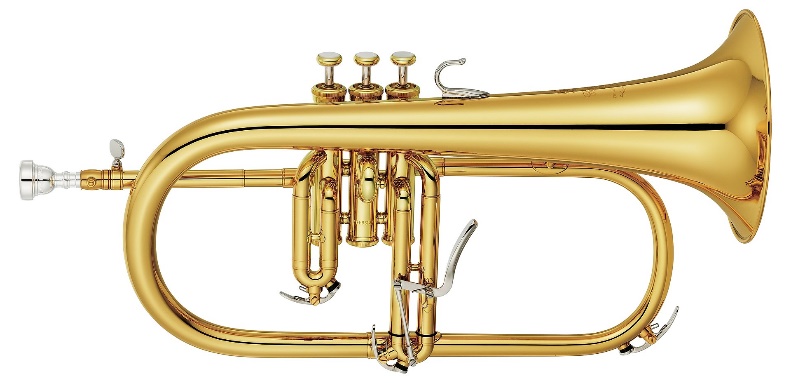
Standard 3 valve flugelhorn
- 4-valve instruments: Due to the harmonic series there literally the trumpet has no limits in the high register (however it is harder to play high), but to play deeper than the fundamental note is physically impossible. To solve this issue trumpet virtuosos like Sergei Nakariakov and Adam Rapa use 4-valve flugelhorn and trumpet. Nakariakov has already played and recorded everything written for the trumpet and decided to play cello pieces on a 4-valve instrument.
- Flumpet: Flumpet is an instrument mixing the characteristics of trumpet and flugelhorn. It was invented by Dave Monette for the jazz legend Art Farmer.
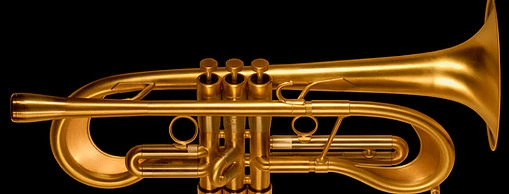
- Dizzy Horn: Dizzy Gillespie’s famous 45-degree bent trumpet was invented by an accident in 1953. “Somebody fell accidentally on Gillespie’s trumpet as it was standing up on a trumpet stand, and as a result, the bell was bent. Gillespie picked it up, played it, and discovered he liked the sound, and that it projected better over the heads of the audience of people in the back of the nightclub.” (Hasse, 2011)

- Ganschhorn, Raven: These two horns mix the rotary and piston valves. However there are many examples of this experiment from other manufacturers, the Schagerl company was the first as a huge company to produce them. The Ganschhorn (invented with a help of Thomas Gansch) has a trumpet and a flugelhorn (Killer Queen) version as well and has a slight bend in its bell. The Raven if rather a mixture of a trumpet and a cornet with a semi-rotary valve construction
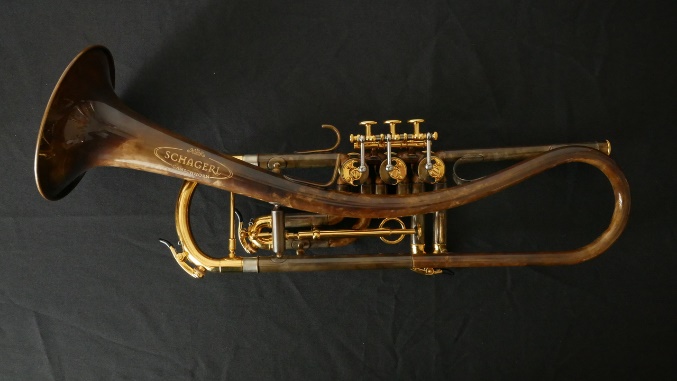
- Pocket trumpet: The pocket trumpet is Bb instrument, has the same length as the trumpet, but it is bended to seem much smaller, which slightly changes its characteristics. It is popular due to its small size.
- Piccolo trumpet: The piccolo is an octave higher than the Bb trumpet (some models are in A) due to its shorter length and makes playing in the high register easier in classical music.

- Slide trumpet (soprano trombone): As mentioned earlier, there are historical bases of the slide trumpet, but it is still in use nowadays. It has exactly the same structure as a trombone, but can be played with a trumpet mouthpiece and has the same register as the trumpet. Wycliffe Gordon is a master of slide trumpet.
- Herald Trumpet, Aida Trumpet: The Herald and Aida trumpets mix the traditional fanfare trumpets with today’s piston-valve trumpets. They are much easier to play than the ancient ones and can play chromatically as well, but in addition they have a flag holder.
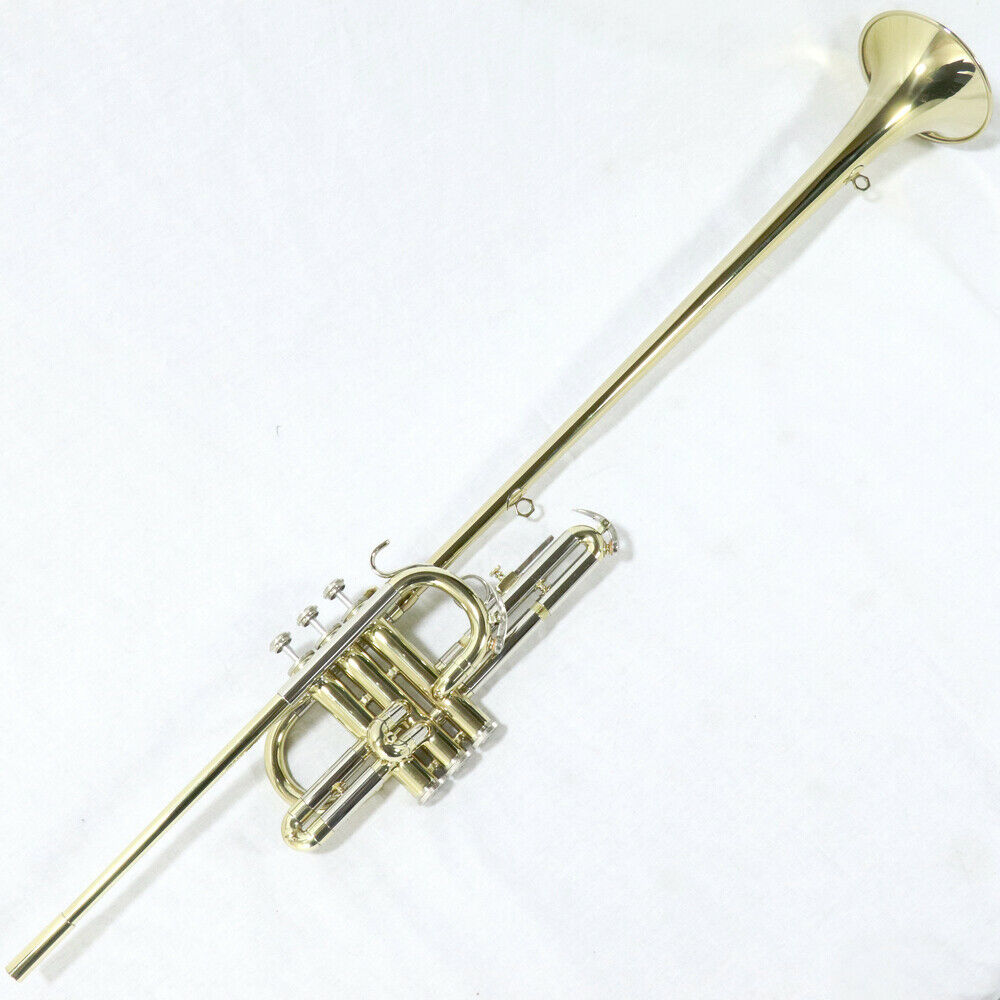
- P-trumpet: However, the P-trumpet doesn’t provide new mechanics or characteristics, it is a remarkable invention, that it is made of plastic. Its tone is very close to the ones made from brass, but they don’t reach the level of being used in professional orchestras. Thanks to its material it is very cheap and can be used as a student instrument or just for fun.
Modern Trumpets We Love
Trumpets have a fascinating history, but they are also fun to play. These are some of my favorites if you are in the market for a new trumpet. From student to professional, these trumpets are some of the best on the market. I chose these based on off-brand, tone, longevity, and long-time user reviews.
Bach BTR201
The Bach BTR201 is a student trumpet similar to something most students will start with. While it’s not the cheapest student trumpet on the market, it’s certainly one of the most high-quality ones.
This trumpet features a seamless bell for control and projection and monel piston valves. It’s available in both lacquer and silver plating for some control of the overall tone.
Pros
- Affordable long-term student trumpet
- Comes with a case and a mouthpiece
- Gold brass leadpipe to extend the lifespan of the instrument
Cons
- Expensive if you aren’t serious about the trumpet
Yamaha YTR-6335
An advancing trumpet player needs a higher quality trumpet that will allow them to expand their technical skills, along with something they can take with them into professional settings. The YTR-6335 is perfect for those tasks.
It features a .459-inch bore and a one-piece 4.8-inch yellow brass bell for superior response and tone. I find this horn to be incredibly versatile with an even tone, perfect for playing solo or with an ensemble.
Pros
- Versatile professional horn for college and beyond
- Great for jazz players
- Yellow brass lacquer or silver options
Cons
- It May take some time to adjust if you are coming from another brand
Adams A4 Selected Series Professional Trumpet
The Adams A4 is one of Adam’s most popular professional trumpet models. It has a complex but versatile tone that works well in nearly a setting but is preferred by soloists. It’s a heavier horn with a thicker rich, and warm tone.
It’s available in a large bore of .470 and a smaller bore of .460, depending on your preferences. However, I’ve found the .470 model to be the most common.
Pros
- Perfect for a soloist but blends in well with a section or ensemble
- 5.5-inch one-piece with a heavy chassis. It’s a heavy horn.
- Warm, rich, and complex tone
- Great for jazz musicians
Cons
- Comes with a gig bag, not a hard case
- Expensive
Yamaha YTR-938FFMS Custom Rotary Trumpet
Rotary trumpets aren’t common in the US, but in they are the standard in Germany and other parts of Europe. The Yamaha rotary trumpet is a loved trumpet from a trusted brand. It’s based on trumpets from the German maker Heckel.
It has three rotary valves, a .443-inch bore, and a 5-⅜ inch one-piece bell. It’s heavier than other trumpets but offers a warm, round tone that people love.
Pros
- Comes with a case and mouthpiece
- Available in the key of Bb or C
- Warm, velvety tone that is very pleasing to the ear
- Pressure formed tubing and hand-lapped valves and slides for smooth airflow and response
- Design
Cons
- Expensive
Adams Sonic Series Bb Flugelhorn
The Sonic model is an intermediate flugelhorn coming in at a cool $2,000. It has three stainless steel valves, a medium .413” bore, and a 6.3” hand-hammered yellow brass bell. It’s known as an easy-to-play horn, and I must admit its sweet sound is beautiful! It’s a beautiful horn, but it’s still relatively expensive. However, it’s perfect for a serious advancing player.
Pros
- Soft, warm tone
- Wonderful for Jazz
- One-piece bell, like the F1
- Recessed valve caps
- Nickel silver accents for weight and density
Cons
- The water key on the first valve loads up quickly.
Trumpet inventions will never stop, and it is almost impossible to collect every type of instrument, but hopefully, this article can give a full picture of trumpet history and trumpet types.
At the end of the article let me share a video of the legendary Chicago Symphony Orchestra trumpet section playing homemade and unique trumpets.
For more interesting readings check out:
Looking for more interesting readings? Check out:
- Best Trumpet Mouthpiece Picks: How To Choose the Right One
- Trumpet Parts Explained
- Piccolo Trumpet Guide: Best Piccolo Trumpets
- How to Find the Best Fugelhorns
- Best Bach Trumpet Options We Truly Stand By
- History and Types of Trumpets You Should Be Familiar With
- The Best Yamaha Trumpet Options For You to Consider
- How to Find the Best Fugelhorns
- Bach Stradivarius Trumpet Review and Guide
- How to Find the Best Trumpet Mute
- Top Trumpet Players of All Time
- Pocket Trumpet Guide: Best Pocket Trumpets in 2022
- Best Trumpet Sheet Music to Learn With
- Trumpet vs Trombone Explained: Which Instrument Suits You Better?

